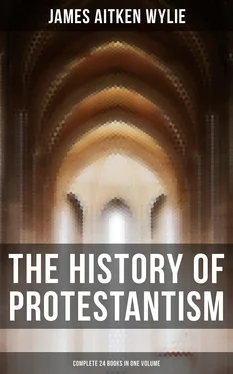Drawing nearer the hills, on a line about thirty miles west of Turin, there opens before one what seems a great mountain portal. This is the entrance to the Waldensian territory. A low hill drawn along in front serves as a defense against all who may come with hostile intent, as but too frequently happened in times gone by, while a stupendous monolith — the Castelluzzo — shoots up to the clouds, and stands sentinel at the gate of this renowned region. As one approaches La Torre the Castelluzzo rises higher and higher, and irresistibly fixes the eye by the perfect beauty of its pillar-like form. But; to this mountain a higher interest belongs than any that mere symmetry can give it. It is indissolubly linked with martyr-memories, and borrows a halo from the achievements of the past. How often, in days of old, was the confessor hurled sheer down its awful steep and dashed on the rocks at its foot! And there, commingled in one ghastly heap, growing ever the bigger and ghastlier as another and yet another victim was added to it, lay the mangled bodies of pastor and peasant, of mother and child! It was the tragedies connected with this mountain mainly that called forth Milton's well-known sonnet: —
"Avenge, O Lord, Thy slaughter'd saints, whose bones
Lie scatter'd on the Alpine mountains cold.
* * *
In Thy book record their groans
Who were Thy sheep, and in their ancient fold,
Slain by the bloody Piedmontese,
That roll'd Mother with infant down the rocks. their moans
The vales redoubled to the hills, and they
To heaven."
The elegant temple of the Waldenses rises near the foot of the Castelluzzo. The Waldensian valleys are seven in number; they were more in ancient times, but the limits of the Vaudois territory have undergone repeated curtailment, and now only the number we have stated remain, lying between Pinerolo on the east and Monte Viso on the west — that pyramidal hill which forms so prominent an object from every part of the plain of Piedmont, towering as it does above the surrounding mountains, and, like a horn of silver, cutting the ebon of the firmament.
The first three valleys run out somewhat like the spokes of a wheel, the spot on which we stand — the gateway, namely — being the nave. The first is Luserna, or Valley of Light. It runs right out in a grand gorge of some twelve miles in length by about two in width. It wears a carpeting of meadows, which the waters of the Pelice keep ever fresh and bright. A profusion of vines, acacias, and mulberry-trees fleck it with their shadows; and a wall of lofty mountains encloses it on either hand. The second is Rora, or Valley of Dews. It is a vast cup, some fifty miles in circumference, its sides luxuriantly clothed with meadow and corn-field, with fruit and forest trees, and its rim formed of craggy and spiky mountains, many of them snow-clad. The third is Angrogna, or Valley of Groans. Of it we shall speak more particularly afterwards. Beyond the extremity of the first three valleys are the remaining four, forming, as it were, the rim of the wheel. These last are enclosed in their turn by a line of lofty and craggy mountains, which form a wall of defense around the entire territory. Each valley is a fortress, having its own gate of ingress and egress, with its caves, and rocks, and mighty chestnut-trees, forming places of retreat and shelter, so that the highest engineering skill could not have better adapted each several valley to its end. It is not less remarkable that, taking all these valleys together, each is so related to each, and the one opens so into the other, that they may be said to form one fortress of amazing and matchless strength — wholly impregnable, in fact. All the fortresses of Europe, though combined, would not form a citadel so enormously strong, and so dazzlingly magnificent, as the mountain dwelling of the Vaudois. "The Eternal, our God," says Leger "having destined this land to be the theater of His marvels, and the bulwark of His ark, has, by natural means, most marvelously fortified it." The battle begun in one valley could be continued in another, and carried round the entire territory, till at last the invading foe, overpowered by the rocks rolled upon him from the mountains, or assailed by enemies which would start suddenly out of the mist or issue from some unsuspected cave, found retreat impossible, and, cut off in detail, left his bones to whiten the mountains he had come to subdue.
These valleys are lovely and fertile, as well as strong. They are watered by numerous torrents, which descend from the snows of the summits. The grassy carpet of their bottom; the mantling vine and the golden grain of their lower slopes; the chalets that dot their sides, sweetly embowered amid fruit-trees; and, higher up, the great chestnut-forests and the pasture-lands, where the herdsmen keep watch over their flocks all through the summer days and the starlit nights: the nodding crags, from which the torrent leaps into the light; the rivulet, singing with quiet gladness in the shady nook; the mists, moving grandly among the mountains, now veiling, now revealing their majesty; and the far-off summits, tipped with silver, to be changed at eve into gleaming gold — make up a picture of blended beauty and grandeur, not equaled perhaps, and certainly not surpassed, in any other region of the earth.
In the heart of their mountains is situated the most interesting, perhaps, of all their valleys. It was in this retreat, walled round by "hills whose heads touch heaven," that their barbes or pastors, from all their several parishes, were wont to meet in annual synod. It was here that their college stood, and it was here that their missionaries were trained, and, after ordination, were sent forth to sow the good seed, as opportunity offered, in other lands. Let us visit this valley. We ascend to it by the long, narrow, and winding Angrogna. Bright meadows enliven its entrance. The mountains on either hand are clothed with the vine, the mulberry, and the chestnut. Anon the valley contracts. It becomes rough with projecting rocks, and shady with great trees. A few paces farther, and it expands into a circular basin, feathery with birches, musical with falling waters, environed atop by naked crags, fringed with dark pines, while the white peak looks down upon one out of heaven. A little in advance the valley seems shut in by a mountainous wall, drawn right across it; and beyond, towering sublimely upward, is seen an assemblage of snow-clad Alps, amid which is placed the valley we are in quest of, where burned of old the candle of the Waldenses. Some terrible convulsion has rent this mountain from top to bottom, opening a path through it to the valley beyond. We enter the dark chasm, and proceed along on a narrow ledge in the mountain's side, hung half-way between the torrent, which is heard thundering in the abyss below, and the summits which lean over us above. Journeying thus for about two miles, we find the pass beginning to widen, the light to break in, and now we arrive at the gate of the Pra.
There opens before us a noble circular valley, its grassy bottom watered by torrents, its sides dotted with dwellings and clothed with corn-fields and pasturages, while a ring of white peaks guards it above. This was the inner sanctuary of the Waldensian temple. The rest of Italy had turned aside to idols, the Waldensian territory alone had been reserved for the worship of the true God. And was it not meet that on its native soil a remnant of the apostolic Church of Italy should be maintained, that Rome and all Christendom might have before their eyes a perpetual monument of what they themselves had once been, and a living witness to testify how far they had departed from their first faith?
CHAPTER 7
THE WALDENSES — THEIR MISSIONS AND MARTYRDOMS
Table of Contents
Читать дальше












